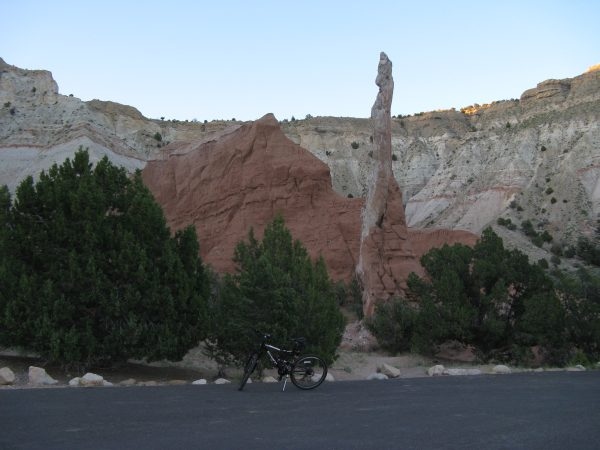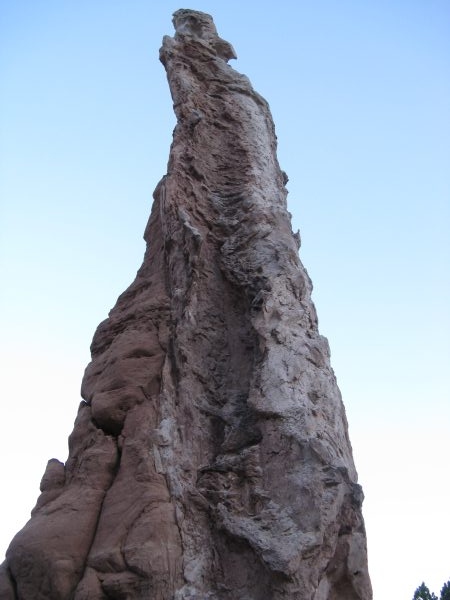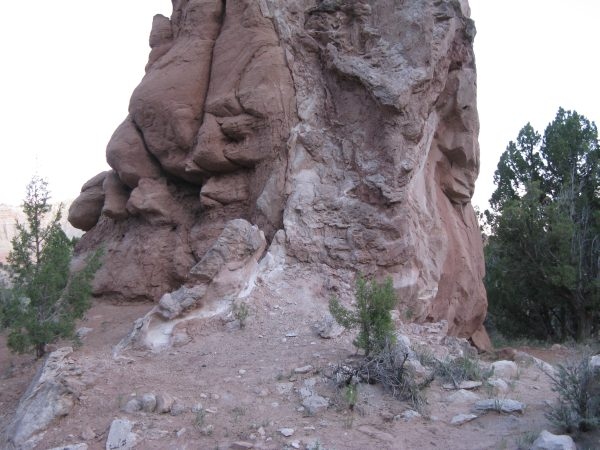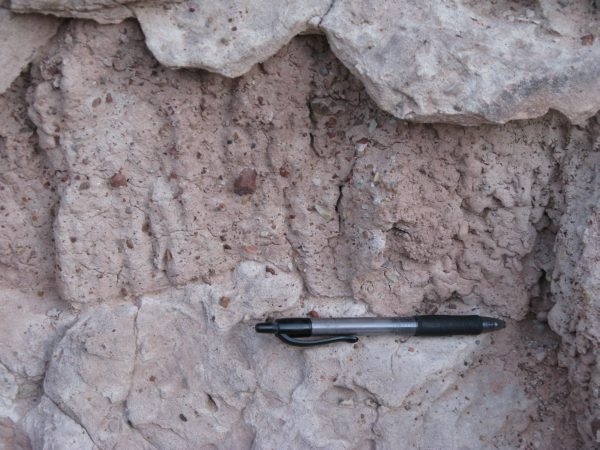|
AN AMATEUR GEOLOGY
ROAD TRIP
My travels through the Colorado Plateau of southern Utah and northern Arizona. by John Fuhring June, 2010 Page 6
To tell the truth, I had no idea the camping would be so nice at Kodachrome Basin, but as nice as it was, that's not the reason I had originally planned to stop there. Many months before my trip I learned that there was something there I should take the trouble to see and so a visit here was one of the main goals of my trip. What I wanted to see was some really mysterious and unique geologic structures - the infamous Sandstone Pipes of Kodachrome Basin. How the sandstone pipes of Kodachrome Basin were formed is the subject of much debate and many hypothesis have attempted to explain their formation. To my mind, these structures are still unexplained and I have not heard a single hypothesis that I find the least bit satisfying. It seems that I'm not the only one who is dissatisfied with the conjectures that have been so far proposed. I just have to laugh when I think about it, but it seems that the (so far) unexplained formation of these pipes has been jumped on by the so-called "Young Earth Creationists" (YEC) and the folks calling themselves (oh I just love this term) "Flood Geologists." To them, because there is as of yet, no good mechanism explaining the formation of these pipes, somehow this is "proof" that the story of Noah's Flood is not just a fable written for simple people living in a pre-scientific age, but actual geologic fact. They expect people - even modern educated people who know the difference between fable and fact - to believe that these structures and all of what we see throughout the Colorado Plateau, were formed during a single year's period somewhat less than 6,000 years ago. Oh lord! Outside of their little "Creation Science Institute" no geologist believes any of that. These are the same people who, because "science" couldn't explain how the sun got from one side of the horizon to the other, it must have been carried by a sacred crocodile and swallowed by the goddess Nut at night only to be pooped out again at dawn (with my worst diarrhea, I never had "The Flaming A's" as bad as that must have been). It was the very mysteriousness of these structures that first attracted my attention and caused me to want to go to see them for myself. Here's what I learned about them: The Sandstone Pipes of the Kodachrome Basin are tall vertical structures that have partially eroded out of a matrix of soft, red, fine grained Entrada Sandstone that was, as mentioned before, formed during the Jurassic. The pipes themselves are of harder, coarser grained and lighter colored sandstone and have resisted erosion much better than the surrounding matrix. Many of the pipes are wholly exposed except at their base. Altogether there are about 70 known pipes within the park. Recently it has been suggested that other pipes may exist in other parts of the Entrada formation at other places outside the park. To try to get some idea of the anatomy of these wonderful structures, I visited a pipe that had been split lengthwise by erosion to reveal its internal structure.  From my Campsite I pedaled to the end of the park to get a close-up look at a pipe that was split down the middle.  A close-up of the back side of the pipe. Looking up from the base you can see the pipe's hollow "urethra" or internal channel extending
from below the base all the way to the top. The sandstone inside
the pipe is quite different in both color and texture from that of the
Entrada matrix and it does not have the horizontal bedding.
 The base of the pipe showing the possible source layer from which the pipe's sand came from.  A close-up of the material within the pipe. This stuff is vastly different from the Entrada Sandstone around it. The leading theories regarding the formation of these pipes are as follows: (1) This area was once the site of hot springs and geysers and these are old geyser tubes. Objection: I very seriously doubt this area was ever the site of hot springs because there is absolutely no evidence of tufa or any other hot springs deposits. The surrounding rock is not mineralized. Besides that, there is no evidence of hydrothermal or volcanic activity dating from this age in any of the formations near here. (2) The sediments were laid down over millions of years and were covered by other thick layers of sediments, but just lay all that time without lithifying into hard rock. At some point, probably as a result of the newly establish subduction zone off the west coast of (what is now) Nevada, earthquakes caused pressurized, water soaked sand to be forced up through cracks in the Entrada Sandstone. Objection: I think the Creationists have a point in that one wouldn't expect deeply buried sand stone layers to remain soft and un- lithified for millions of years until earthquakes caused sand to boil out of the ground. While it is true that earthquakes do cause "sand boils" in water soaked fill materials (as has been observed where San Francisco Bay was filled in), production of sandstone pipes this tall by this means seems to be unlikely at best. Besides that, the effects of earthquakes, even ones caused by "super-volcanoes" associated with the new subduction zone would have to awesome indeed to have effects this far inland. (3) Meteor strikes created holes in the Entrada Sandstone that allowed pressurized sand/water mixture to make its way to the surface. Objection: Pretty absurd suggestion when you consider the shape of the pipes and the likelihood for something like this happening.. (4) All sediments were in a very soft, un-lithified state about 4,500 years ago when the waters that had covered earth a few months earlier receded. The entrada sediments, being so soft, would allow pressurized sand and water to make its way to the surface. Objection: This is so absurd as to require no rebuttal, but I will say this: if the formations were so soft that pressurized sand could get through them, how were they and the sand so strong as to stand up as cliffs a few days later when most of the soft, un-lithified sediments from Noah's Flood were washed away? Overall objection to all the above theories: The big question in my mind is where the sand and sub-angular gravel particles come from. They sure didn't come from underlying formations because the Carmel Formation that underlies the Entrada is made up of shallow marine mudstones and sabra deposits (containing gypsum and evaporates). As far as I know, the sand and gravel did not come from below and was not "squeezed" out through thick layers of soft, un-lithified host rock. My guess regarding the source of the sand and sub-angular quartzite pieces is that they came from above, from the now eroded away and vanished late Triassic Morrison formation. To my eye, the larger clasts look a lot like Brushy Basin stuff I've seen before. Of course it could have come from Naturita (AKA Dakota) Formation which actually overlies (or used to overly) these pipes. So, the next question is, if younger, more course stuff was washed down into nice round holes in the Entrada Sandstones, how did the holes get there? That's a problem I can only answer with another of my crackpot theories. John's crackpot theories: (1) During the late Jurassic there were many fantastic dinosaurs, most of which we will never know about because they never fossilized. One very bizarre type dug deep burrows to escape predators. The shafts these creatures dug filled up with Morrison or Naturita gravels after they were abandoned. Objection: This does account for the sand and gravel, but without fossilized specimens to lend credence to the suggestion, it is pretty absurd. Some kind of fossilized remains of such creatures, if they exist at all, should be found somewhere within the sandstone structures. (2) At the time the swift flowing streams were laying down the gravels of the Morrison Formation, unusually deep pot holes were excavated deep into the beds of these rivers and into the soft Entrada Sandstone beneath. At some point stream conditions changed and the holes filled up with sand and gravel. Objection: Why aren't the deposits stratified vertically and why does the center of these pipes appear to be hollow? Where are the "grinding stones" that should be found at the bottom of a pot hole? (3) Huge volcanoes associated with the magmatic arc of the subduction zone off the west coast dropped some ash that was especially acidic and pools of the stuff ate their way vertically through the calcareous binding material of the soft Entrada sandstones allowing sand and gravels to wash down. Objection: Again, why aren't the deposits stratified vertically and why does the center of these pipes appear to be hollow? Well, I can see we aren't going to settle this question here. I wish I was still in graduate school because I think this Kodachrome Basin might be worth a Master's or even a Doctoral Thesis.
END OF CHAPTER 2
|